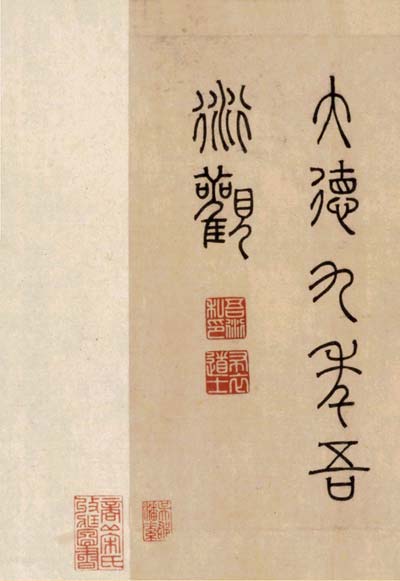Wu Yan (1272-1311), also known as Wu Qiu Yan, also known as Zixing, also known as Zhufang, also known as Zhenbai Jushi, was a native of Quzhou (Zhejiang) in the early Yuan Dynasty and lived in Hangzhou. He loves ancient times and is knowledgeable, and he teaches in seclusion and is self-sufficient. Xu Yan, the official envoy of the Lian Dynasty, came to visit, but he did not receive him. Later, he was arrested because of the lawsuits filed by his in-laws. His justice was not insulted and he died in the water. He has written books such as "Synopsis of Shangshu", "Annotations of Zhou and Qin Carved Stones", "Xuegu Bian", "Yin Shi", "Nine Songs Pu", "December Music Score", and "Zhusu Shanfang Collection". "History of the New Yuan Dynasty" was included in Wenyuan Biography.
Wu Yan was eighteen years younger than Zhao Mengfu, and he and Zhao Mengfu were literary friends. Zhao Mengfu specializes in seal cutting with round Zhu inscriptions, and Wu Yan also advocates using small seals as the basis. Paleophilology was in a period of decline during the Song and Yuan dynasties. The "Xuegubian" written by Wu Yan, the main part of which is "Thirty-Five Examples", is the earliest theoretical guidance book for the study of seals in my country. In "Thirty-Five Moves", the first seventeen moves discuss the method of writing seal script; after the eighteenth move, they all discuss engraving, introducing one's own creative experience, which is quite specific. There were not many antiquities available at that time, so this book has certain limitations. But it first points out that "when learning seal script, "Shuowen" is the foundation. If you can understand "Shuowen", your writing will be good" (Four Jus). He also said, "Han seal script has many changes in ancient methods, and Xu's "Shuowen" saved it" (Sixteen Examples). This is absolutely correct. In Wu Yan's time, there were very few people who knew seal script. His retro-reflective thinking had a positive significance for the development of seal learning at that time. It is no wonder that the book "Thirty-Five Movements" was compiled by many people in the field of seal studies at that time and for a long time afterwards, and was regarded as a classic work. He Zhen in the Ming Dynasty had "Continuing to Study Ancient Compilations", Guifu in the Qing Dynasty had "Continuing Thirty-Five Jus" and "Continuing Thirty-Five Jus", Wu Zi and Huang Zigao both had "Continuing Thirty-Five Jus", and Yao Yan also had "Continuing Thirty-Five Jus". "Thirty-Five Moves Again", Wuqiu's study has always been highly praised by seal scholars.
Xia Pu was Wu Yan's friend in his early years. He wrote the "Preface to the Study of Ancient Times", which detailed Wu Yan's life as a private school student in Hangzhou. Talking about his seal management: "Private seals include 'Zhusu Shanfang', 'Wushi Zixing', 'I am the laziest', 'Fang Huai Zhenle', and 'Fei Danxiao'. This number of seals are printed together with Xiaowei belt on the nose." , often rub it with your hands." He also said: "...it changed the fallacy of the Zhongding Book in the late Song Dynasty, and printed ancient seal scripts. It was actually advocated by Mr. Zhao, and he was the first to learn it. Mr. Zhao Wuxing later imitated it." Xia Pu pointed out that Zhao Mengfu followed Wu Yan late, but few people knew about it. Depending on the situation, it is true that Wu Yan’s martial arts are deep and Zhao’s status is high, so the two of them influence each other.

Very few of Wu Yan's works have been circulated. Today we can only see his seal script inscriptions and seals at the back of Du Mu's "Zhang Haohao Poems". The seven-character seal script "Wu Yan Guan in the 9th year of Dade" is extremely sophisticated, and its style is close to that of "Shigu Wen". The two seals "Wu Yan Private Seal" and "Buyi Taoist" are both written in white, and they also have the essence of Han seals. He can be regarded as a great master.








